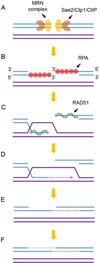Mechanisms and Consequences of Double-Strand DNA Break Formation in Chromatin
- PMID: 26040249
- PMCID: PMC4994891
- DOI: 10.1002/jcp.25048
Mechanisms and Consequences of Double-Strand DNA Break Formation in Chromatin
Abstract
All organisms suffer double-strand breaks (DSBs) in their DNA as a result of exposure to ionizing radiation. DSBs can also form when replication forks encounter DNA lesions or repair intermediates. The processing and repair of DSBs can lead to mutations, loss of heterozygosity, and chromosome rearrangements that result in cell death or cancer. The most common pathway used to repair DSBs in metazoans (non-homologous DNA end joining) is more commonly mutagenic than the alternative pathway (homologous recombination mediated repair). Thus, factors that influence the choice of pathways used DSB repair can affect an individual's mutation burden and risk of cancer. This review describes radiological, chemical, and biological mechanisms that generate DSBs, and discusses the impact of such variables as DSB etiology, cell type, cell cycle, and chromatin structure on the yield, distribution, and processing of DSBs. The final section focuses on nucleosome-specific mechanisms that influence DSB production, and the possible relationship between higher order chromosome coiling and chromosome shattering (chromothripsis).
© 2015 Wiley Periodicals, Inc.
Conflict of interest statement
The authors of this study have no financial conflicts of interest.
Figures




References
-
- Baker DN, Jaynes AN, Hoxie VC, Thorne RM, Foster JC, Li X, Fennell JF, Wygant JR, Kanekal SG, Erickson PJ, Kurth W, Li W, Ma Q, Schiller Q, Blum L, Malaspina DM, Gerrard A, Lanzerotti LJ. An impenetrable barrier to ultrarelativistic electrons in the Van Allen radiation belts. Nature. 2014;515(7528):531–534. - PubMed
Publication types
MeSH terms
Substances
Grants and funding
LinkOut - more resources
Full Text Sources
Other Literature Sources

